French food is one of the most popular cuisines in the whole world. People from all over the world have been attracted to this incredible style of cuisine, with its emphasis on fresh ingredients, creative cooking techniques, and art de la table presentation.
Composed over the centuries in the various regions of the country, these amazing delicacies have been exported around the world. Whether you are in a brasserie in Paris, at a seaside resort in Saint-Tropez, or in a French restaurant in overseas, there are certain dishes that have come to epitomize La France.
And although plenty of visitors will say that there is nothing like discovering these gastronomical delights in situ eating and drinking your way through France, it’s also possible to do so at home. In certain cases, I have also included the recipes so you can make your own version.
So with that, here are the top traditional French foods, and most popular dishes and drinks in France. Bon appétit!
- 1. Escargot
- 2. French onion soup
- 3. Foie Gras
- 4. Cuisse de grenouilles (frog legs)
- 5. Croissants, viennoiseries, and breads
- 6. Socca
- 7. Panisse
- 8. Tomates à la Provençale
- 9. Coquilles St. Jacques
- 10. Moules frites
- 11. French Wines
- 12. Fondue
- 13. Raclette
- 14. Quiche Lorraine
- 15. Crêpes
- 16. Cassoulet
- 17. Tartiflette
- 18. Boeuf Bourguignon
- 19. Aioli
- 20. Croque Monsieur
- 21. Steak Tartare
- 22. Ratatouille
- 23. Bouillabaisse
- 24. Coq au Vin
- 25. Blanquette de Veau
- 26. Salade Niçoise
- 27. Chicken Provençale
- 28. Oysters
- 29. Charcuterie and cheese platter
- 30. Quenelles
- 31. Macarons
- 32. Calissons
- 33. Café Gourmand
- 34. Meringue
- 35. Religiouse
- 36. Vin Chaud
- 37. Pastis
- 38. Kir
- 39. Chocolat chaud
- 40. Dijon Mustard
- 41. Cognac and Armagnac
- 42. Boudin Blanc
1. Escargot
Yes, I had to start this list with snails. Rather than being squeamish, if you have ever had escargots, you know that they are actually a delight.
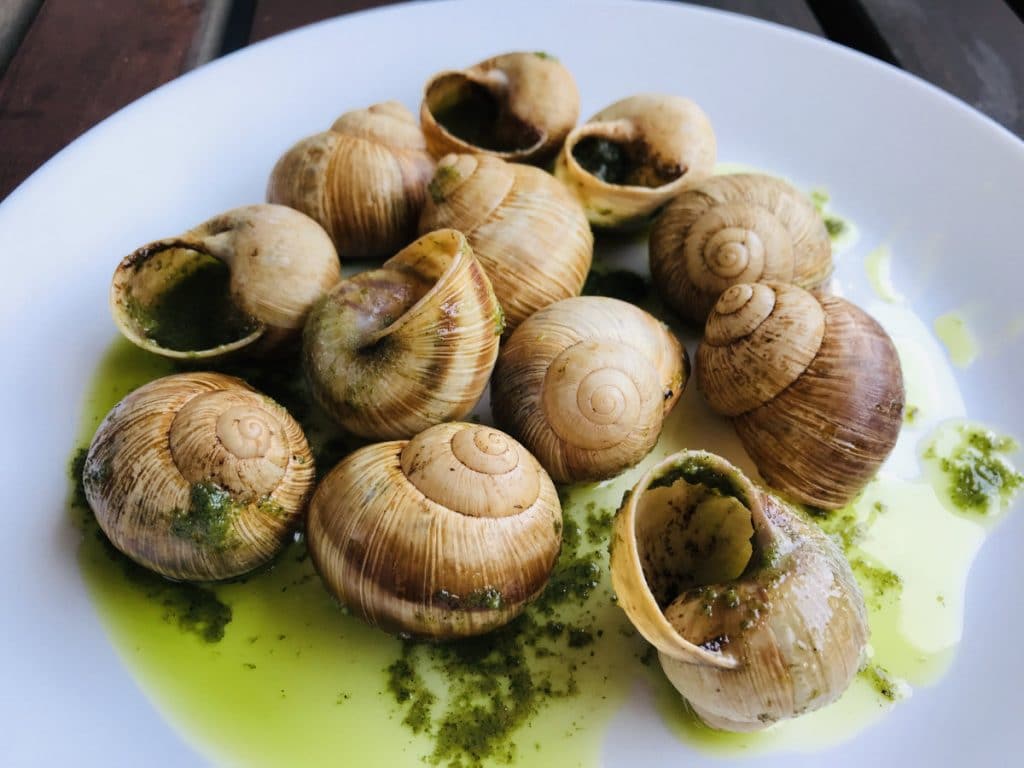
Yes, escargot are the same snails that you might find in a forest, and yes, French people do cook them up (usually in garlic, oil and pesto/pistou sauce) and eat them regularly.
The little balls of meat easily go down with some baguette to soak up the buttery sauce. It is estimated that French people eat 16000 tons of escargot every year. You can read more about eating escargot here.
2. French onion soup
The French onion soup should perhaps be called the Royal French onion soup, since it became famous after being served to French King Louis XV (by ex-Polish King Stanislas Leszczynski).
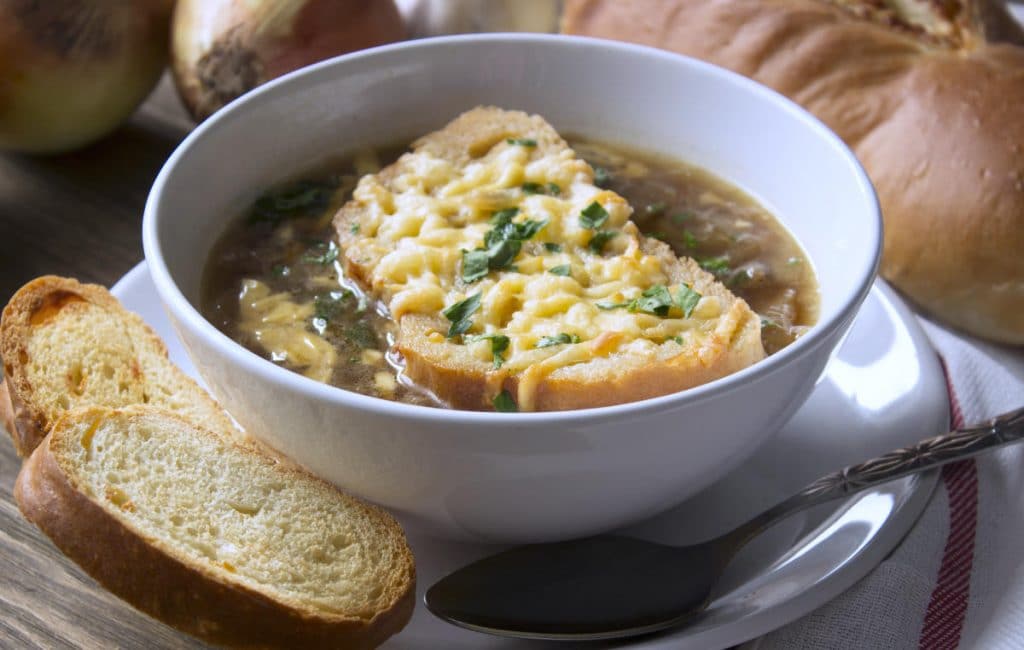
The onions are cooked till they are lightly brown in color so that they are perfectly caramelized. Then they are cooked in a broth and topped with a sumptuous amount of grated cheese.
Each chef has his own combination of cheeses, but the most popular are gruyère, saint nectaire, mimolette, comté, emmental, or cantal. A dish truly fit for a king. You can get the recipe to make French onion soup at home here.
3. Foie Gras
Whether you are celebrating Christmas in France, or just a regular evening with friends, foie gras is an incontournable (an essential).
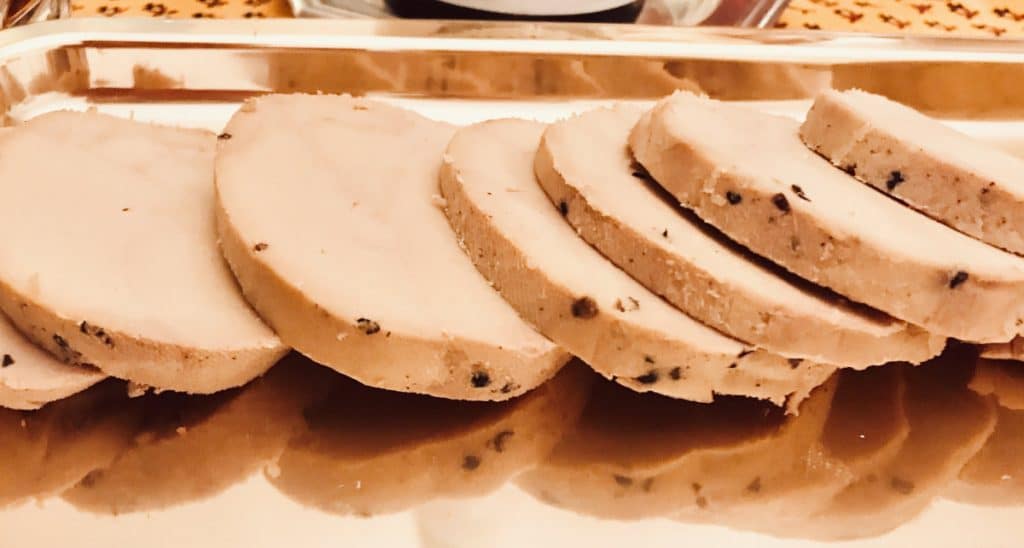
In France, there are many types of foie gras that you can find. The process dates back to antiquity and is legally protected. There are different types of foie gras, from the most expensive to cheaper as follows:
- foie gras entier – means “whole foie gras” which is made of one or two whole livers
- foie gras – made of pieces of livers reassembled together
- bloc de foie gras – a fully cooked, assembled and moulded block made of 98% or more of foie gras
And if foie gras itself is too expensive, you can also try a pâté of foie gras. It is usually cut in slices and arranged on a tray, along with some mini toasts. Pair them together and munch away. You can read more about eating foie gras here.
4. Cuisse de grenouilles (frog legs)
Frog legs are a delicacy which have been eaten for centuries. Born out of food shortages and necessity, cuisses de grenouilles (meaning “frog thighs”) have been part of French cuisine for over a 1000 years.
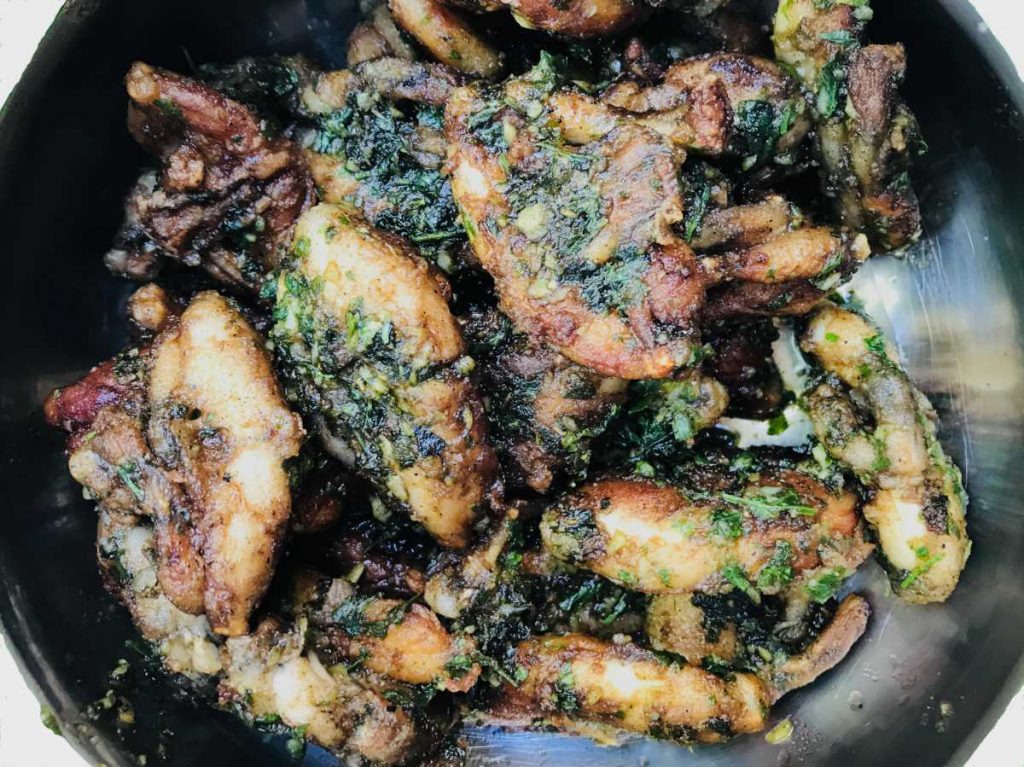
There are two main ways that frog legs are cooked, either deep fried or baked with herbs.
There are variations of these types of dish serving cuisses des grenouilles all over France, from Michelin-starred restaurants to local brasseries, and even grocery shops. You can read more about eating frog legs in France here.
5. Croissants, viennoiseries, and breads
Legend has it that the croissant was a tradition that the young Marie-Antoinette of Austria brought with her to France, when she married French King Louis XVI. Hence it became known as a viennoiserie or “thing from Vienna (the capital of Austria)”.

Today, croissants and other viennoiseries like pain au chocolat, chausson aux pommes, etc. are an indelibly considered French foods (although, the Austrians might disgree).
While you can find croissants all over the world these days, there is nothing like a french croissant, light and airy fresh out of the oven.
And when it comes to fresh baked goods, we must not forget about the variety of baguettes and French breads that are so popular in France.
6. Socca
A classic dish in Provence and the South of France, socca is a type flatbread made with chickpea flour. It is usually served as an appetizer and is meant to be finger food.
Socca is usually served without sauce, but some restaurants will serve it with a small dip like a tomato provençale sauce or sauce vierge.
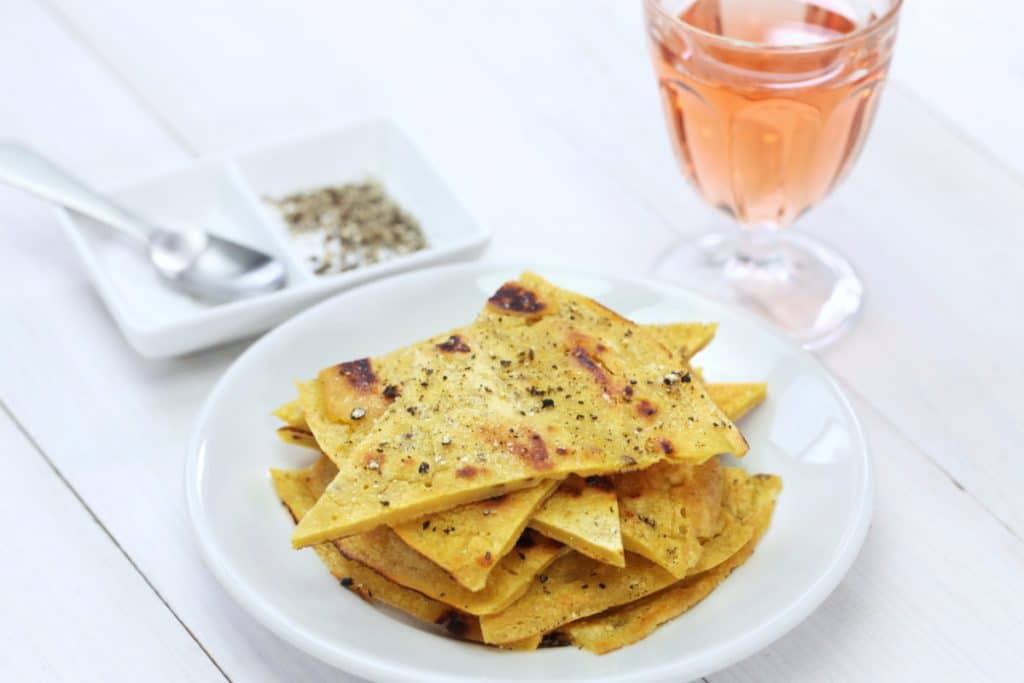
Originating in Nice, socca is quite easy to make, a bit of olive oil, salt and pepper, and of course chickpea flour and you are good to go. You can check out the recipe to make socca here.
7. Panisse
Another appetizer similar to the socca is panisse, which is also perfect as finger food for an apéro or happy hour.
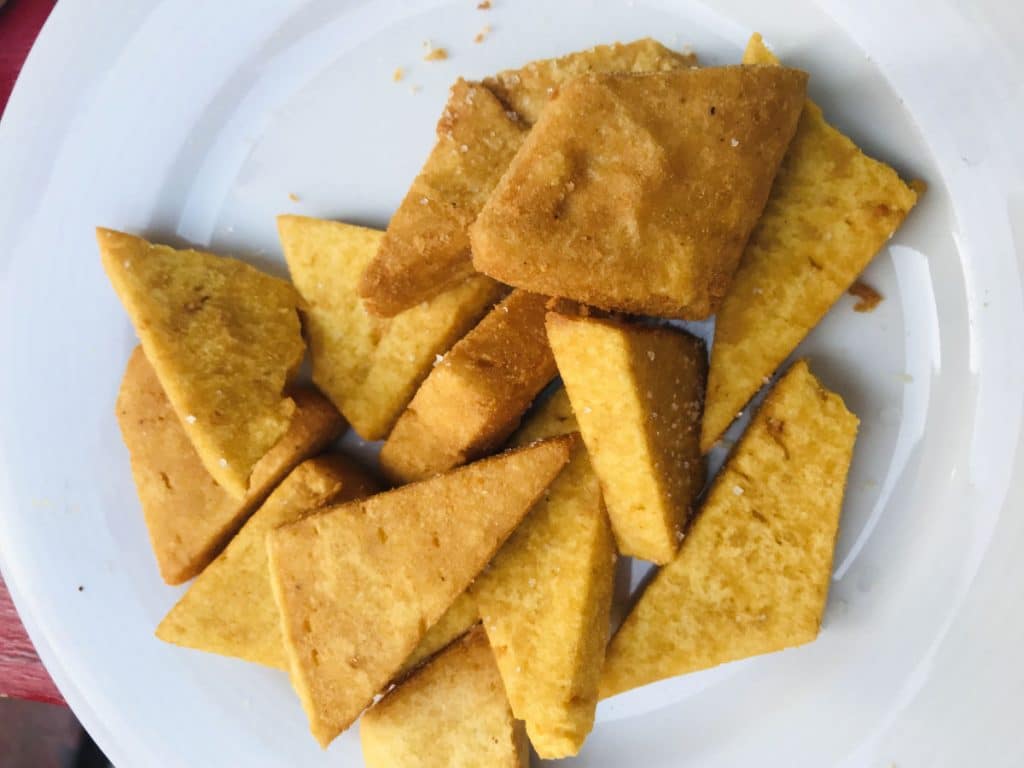
Originating in Nice (or Marseille), panisse is also made with chickpea flour and can be baked or fried.
Dairy-free and gluten free, it is one of those finger foods that you will find all over the south of France. You can get the recipe to make panisse here.
8. Tomates à la Provençale
Tangy sweet tomatoes, sprinkled with oil and crispy breadcrumbs, it doesn’t get more exquisite than this.
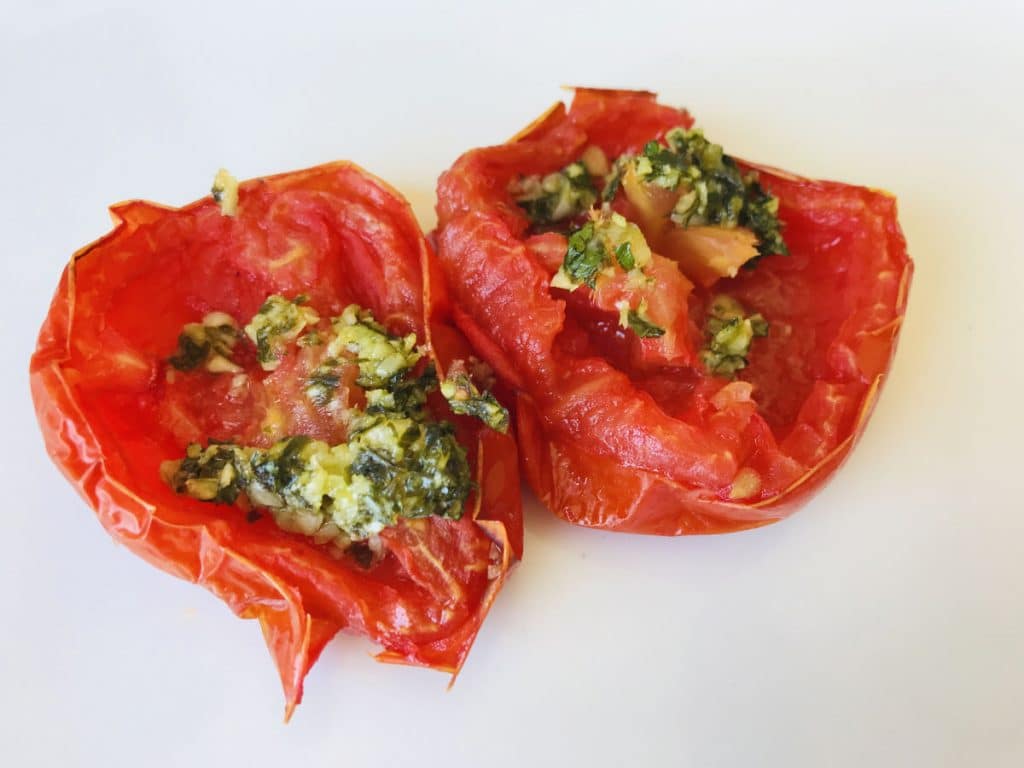
Provencal Tomatoes, or tomates à la provençale in French, is a typical French starter in the south of France.
The 3 keys to cooking any provençale dish are olive oil, garlic, and the aromatic herbs and to that end tomates à la provençale has it all in spades. The tomatoes are drenched in olive oil, garlic and various herbs.
They are then cooked for a long time and it is that long cooking process that makes the herbs and garlic meld into the tomato juice to then give it a tangy, almost bitingly caramelised flavor.
The sum becomes more than its parts. You can get the recipe to make tomates à la provençale here.
9. Coquilles St. Jacques
Coquilles St Jacques (scallops in English) is named after the pilgrims of Saint Jacques de Compostela who crisscrossed France and Spain with the seashells around their neck.
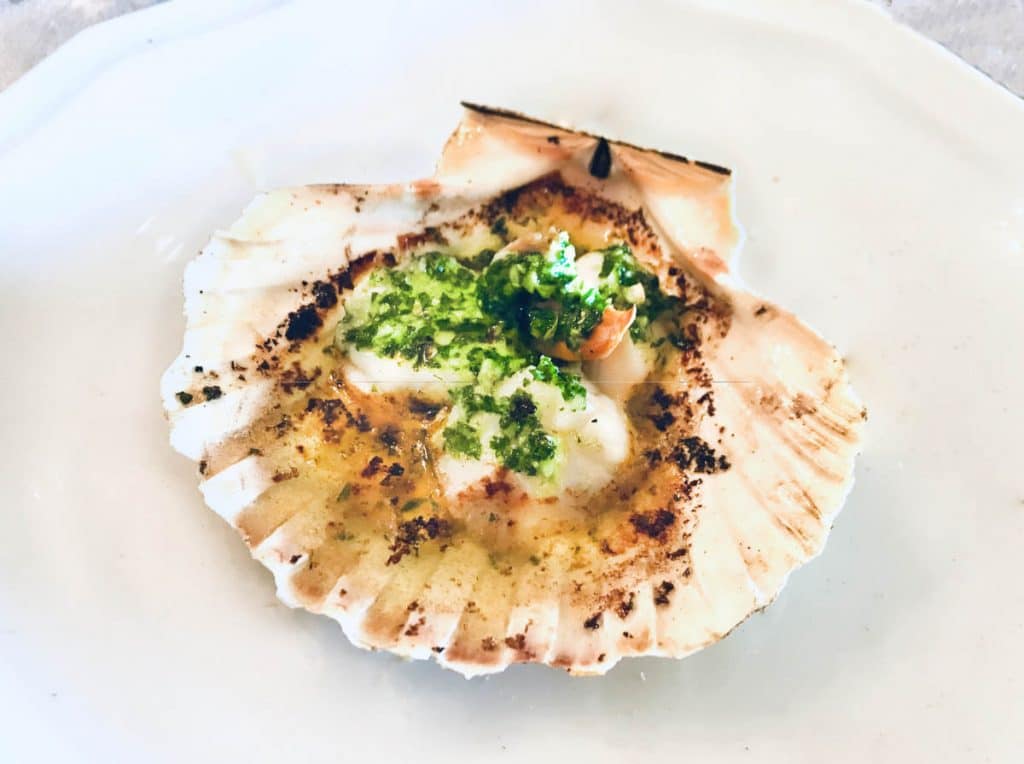
There are many ways to prepare the scallops: raw, marinated, fried or grilled. But one of the most popular in France has to be Coquilles St Jacques with pesto sauce (or pistou), which has a bit of a kick to it. And has the added benefit of being gluten-free, lactose-free and alcohol-free.
Another favorite is Coquilles St Jacques en gratin, where it is cooked with a creamy sauce and breadcrumbs. That one is obviously not gluten-free, since it has breadcrumbs. You can get the recipe for coquilles st. jacques in pesto here.
10. Moules frites
The region of Normandy and Brittany on the west coast of France is quite famous for its seafood. One of the delicacies of the area are the moules frites, meaning mussels and fries.
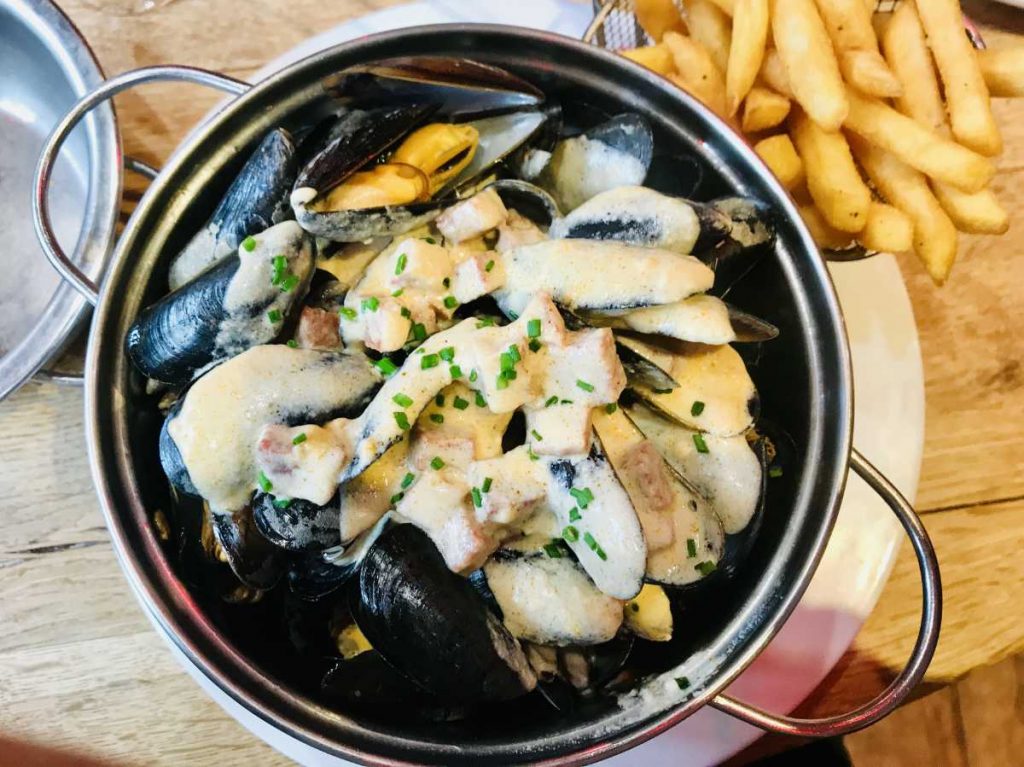
This is one of the classic French foods that you simply have to try if you are in France.
The moules are usually steam cooked and then served mixed with a variety of sauces such as with parsley, or with cream and lardons, and many many more.
11. French Wines
French wines are renowned for their quality. The French wine market is the fifth largest in the world and it’s worth around $30 billion a year, so you can imagine how good they are.
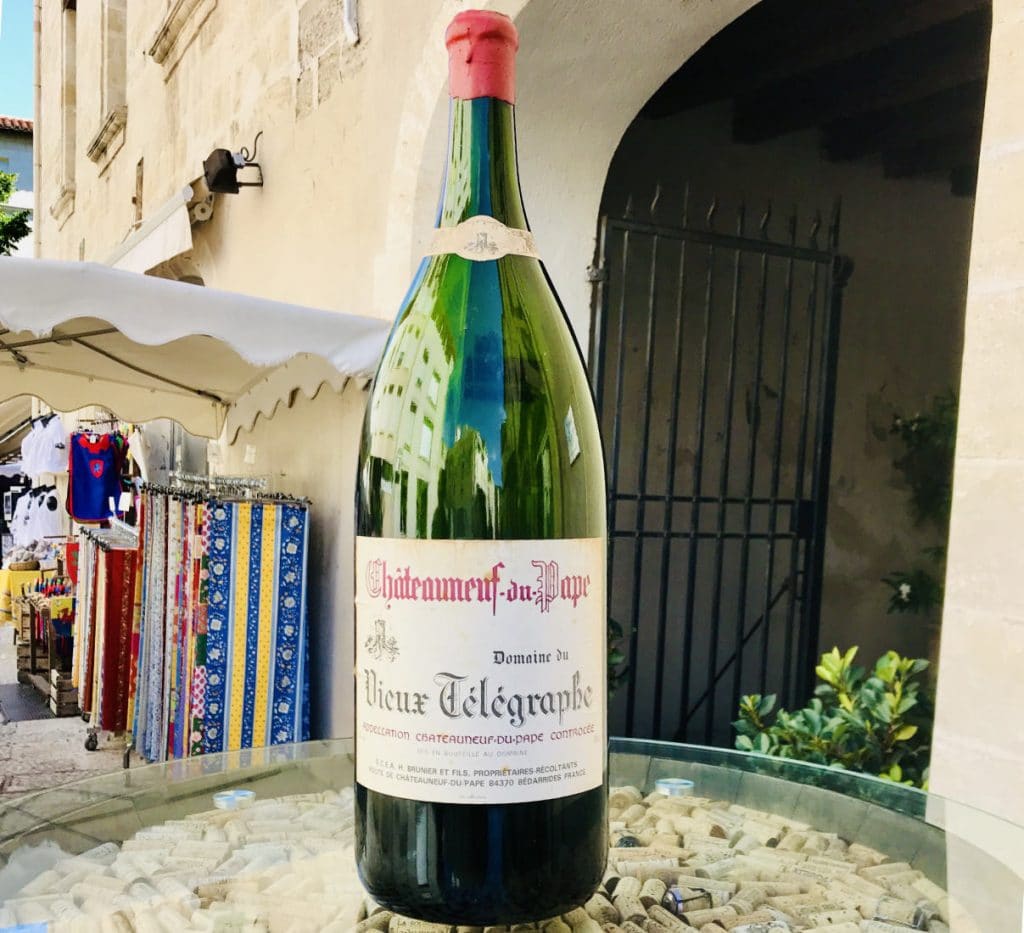
There are of course many many wine regions in France, but the most popular are:
From red wines, white wines, rosés, sparkling wines, and fortified wines (digestifs), there is a bit of everything. And of course, we can’t forget champagne!
In France, only wine and water is usually served at dinner (and sometimes lunch), rather than beer, sodas or other drinks. You can read more about picking a French wine here.
12. Fondue
After a long and snowy day, enjoy time with family and friends with this melted cheese dish from the Alps mountains.
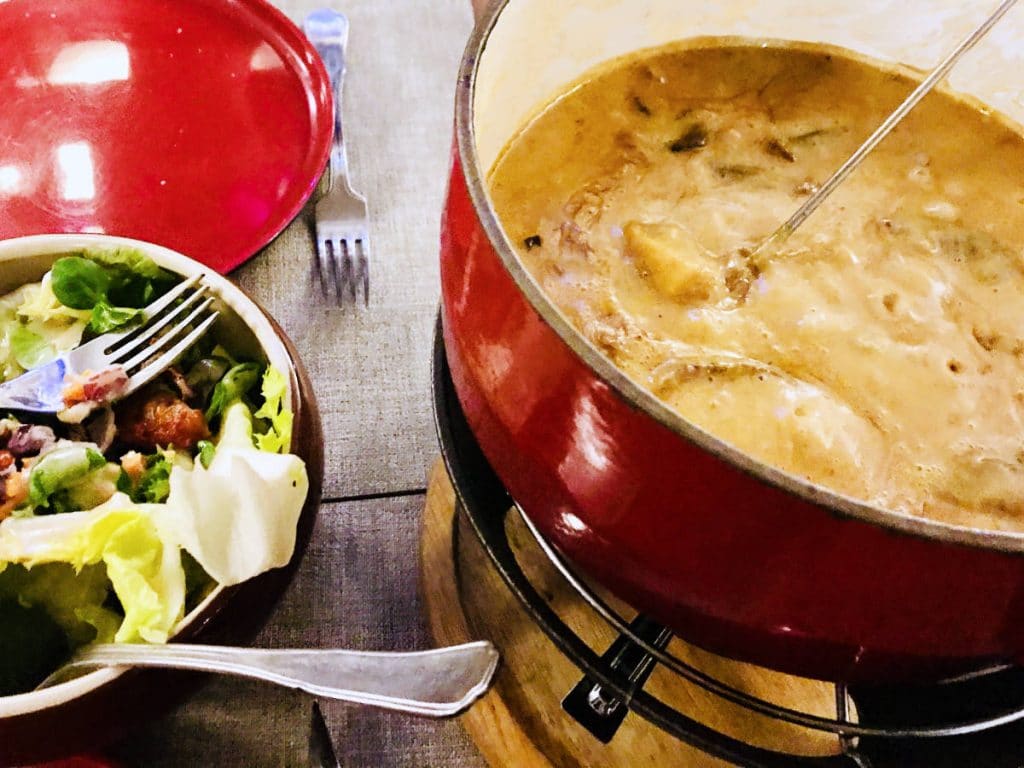
Fondue comes from the French word “fondre” which means to melt. There are many combinations of cheeses that to make a cheese fondue, from reblochon to goat cheese.
Different towns in the Alps, and indeed different chefs, will have their own special touch to add to their cheese fondue. There are also different versions including items like mushrooms or tomato sauce for added flavor. You can read more about making a fondue here.
13. Raclette
Another cheesy dish that comes from the French and Swiss Alps is the raclette. After a long day of skiing (and even if you haven’t been skiing), sit down and share a raclette with family and friends.

Raclette is a semi-hard type of cheese, traditionally made from non-pasteurized milk.
Friends and family gather together at the end of the day and cook the cheese together, melting it to place on top of potatoes and charcuterie (salt-cured hams). You can read more about eating raclette here.
14. Quiche Lorraine
The classic quiche dish comes from the old department of Lorraine in France, on the edge of the French-German border. These days the department of Lorraine is part the Alsace region, and the traditional quiche lorraine is dish that is much loved.
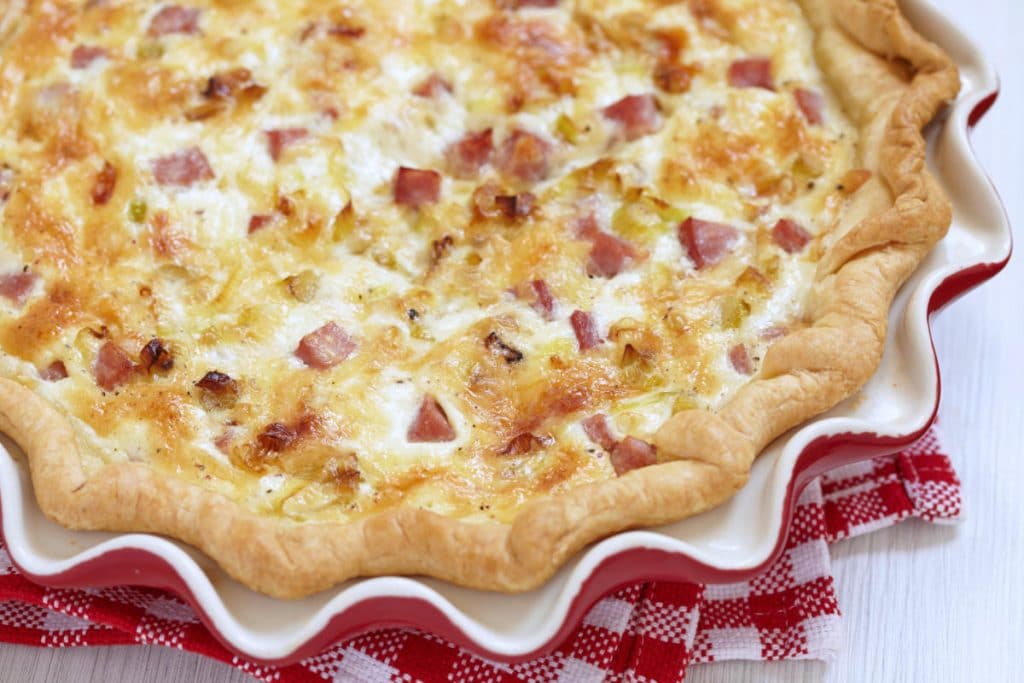
The traditional recipe includes bacon lardons, cheese and cream, and plenty of it.
With a base of pie crust and egg, chefs everywhere can add any othr types of ingredient they want, such as spinach and cheese, salmon, leeks, etc. You can read the recipe for a quiche lorraine here.
15. Crêpes
North Americans may have pancakes, but the French have crêpes. From savory to sweet, they are a blank canvas that can be filled with almost any ingredient you want.
Savory crêpes use buckwheat flour, and can have traditional toppings are ham, eggs and cheese, but you can get other ingredients like spinach, mushrooms, etc.
Sugary crêpes like the crêpe suzette, on the other hand, are usually made from all-purpose flour and are lighter to be served as dessert.
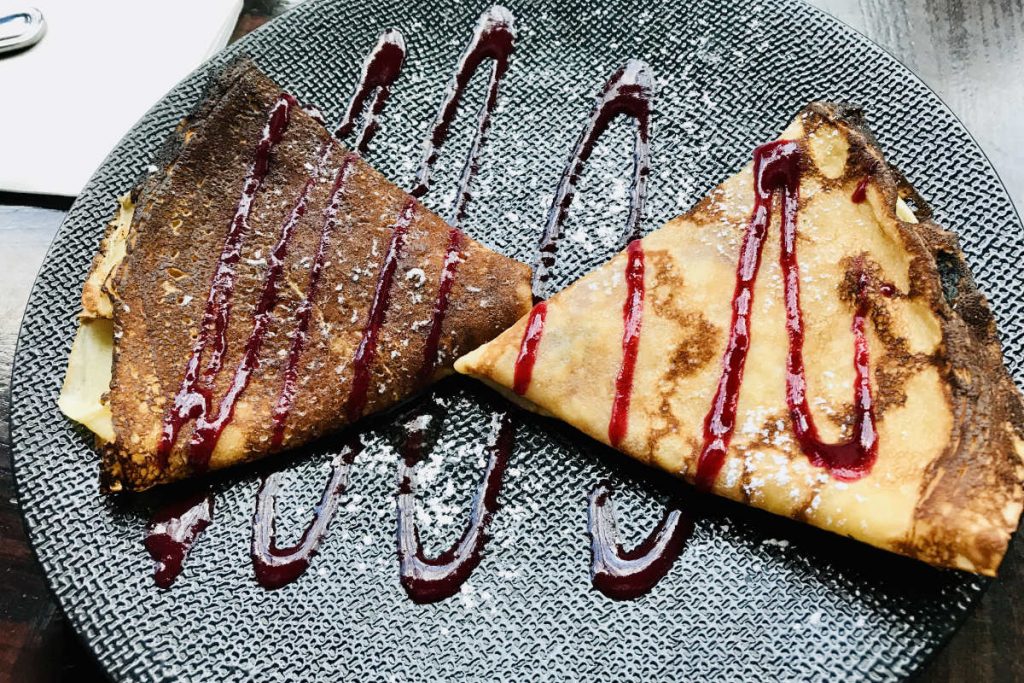
There is even a bit of a holiday around the crêpe during Chandeleur (Candlemas). La Chandeleur where French people usually gather around at someone’s house on the nearest Sunday afternoon, and watch the chef serve up copious amounts of crêpes.
Sugary or savory, the crêpes are usually served with large pitchers of cider, another French classic. There is also a version from Brittany called the galette bretonne.
16. Cassoulet
Dating back to the 1300s from the Languedoc region of France, the cassoulet has been around a long time. A delectable stew made with beans, meat, and sausages, it is traditionally slow-cooked for hours.
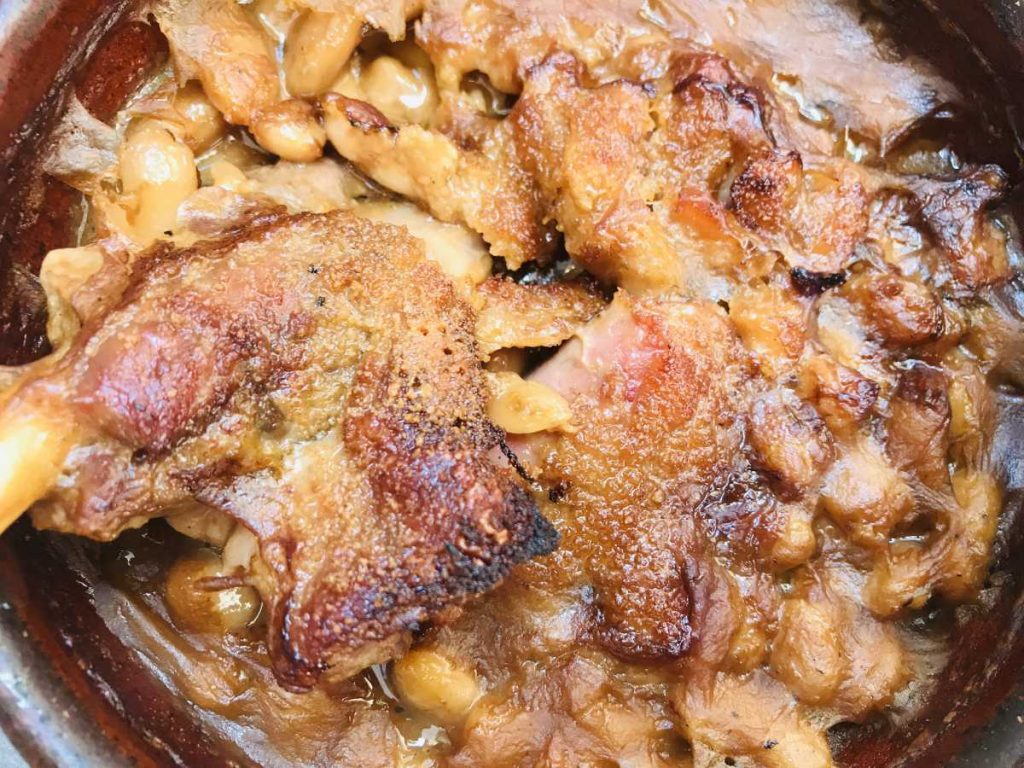
The word cassoulet comes from the earthenware casserole it is cooked in, the cassolle or cassolo, which is made by local potteries nearby.
Aficionados of the cassoulet will note however that is a “guerre des cassoulet” (meaning “war of the cassoulet”) between the different towns that are well known for their cassoulet: Castelnaudary, Carcassone and Toulouse.
Each has its own variation, with differences between the sausage used, how long it is cooked and more. Each year cook-offs are usually held to see who takes home top prize with bragging rights. You can read more about the recipe for Cassoulet here.
17. Tartiflette
If you like cheese and potatoes, there is nothing not to like about a tartiflette. Easy to put together, this hearty meal has copious amounts of reblochon cheese and bacon lardons topped onto sliced potatoes.
One of the most popular French potato dishes, it is usually served as a main, but you can have it as a side as well.
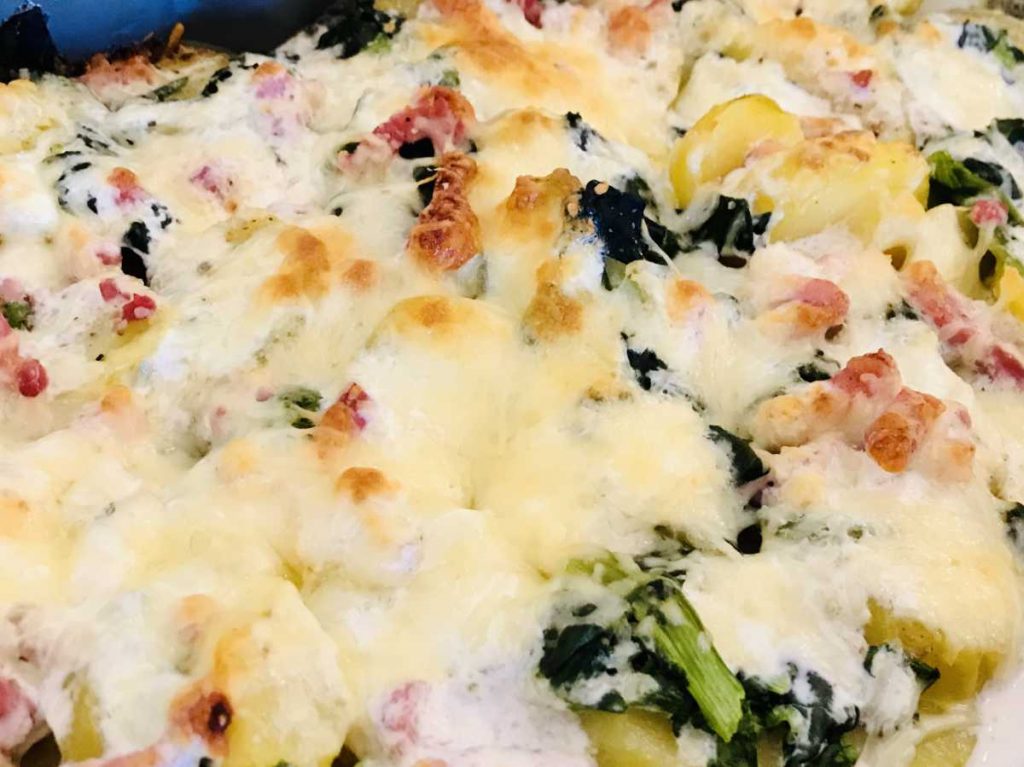
If you are a connaisseur of French gastronomy, you will note that the ingredients in a tartiflette are suspiciously quite similar to that of au gratin potatoes.
In fact, the main difference is that for au gratin potatoes, you can use more or less whatever cheese catches your fancy, while a tartiflette must include the aforementioned reblochon cheese. You can get the recipe for tartiflette here.
18. Boeuf Bourguignon
In the Old Country, you perhaps couldn’t afford your ideal cut of beef. The answer was a hearty and rich stew, the traditional boeuf bourguignon.
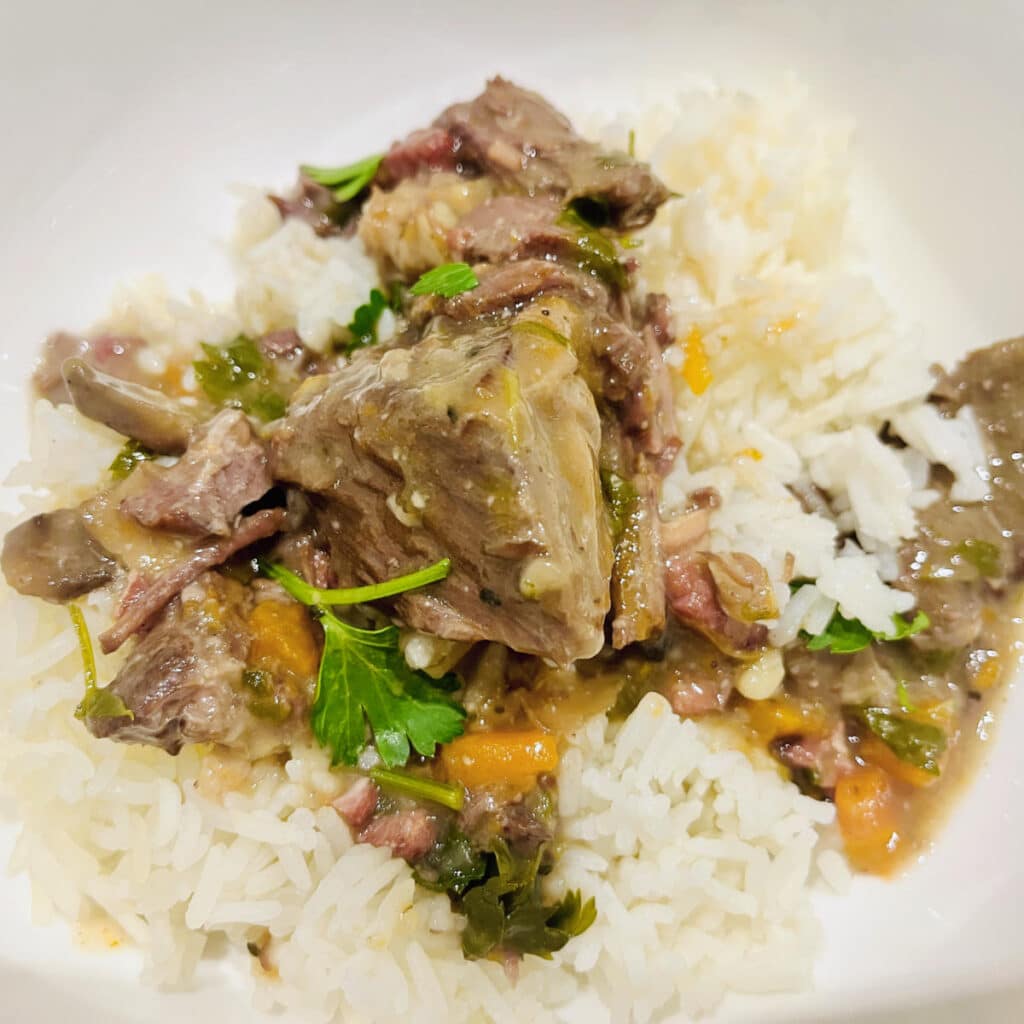
Boeuf Bourguignon is traditionally from the region of Burgundy (Bourgogne) in France. So it stands to reason that they would want to combine the two delicacies that they are most famous for: Burgundy beef and Burgundy wine.
The typical cut of meat that is used in boeuf bourguignon is not the tenderloin, but the more affordable beef chunk. Slow cooking meat for several hours, along with vegetables and wine, this is a French dish that has become a true classic. You can get the recipe for boeuf bourguignon here.
And if you prefer a dish without alcohol, try the boeuf pot au feu (or the chicken version.)
19. Aioli
If you wander through the city of Marseille on the French Riviera, you will see plenty of restaurant menus proudly declaring that they serve “aioli”. But aioli is not actually a dish in itself, it is one of the famous French sauces.
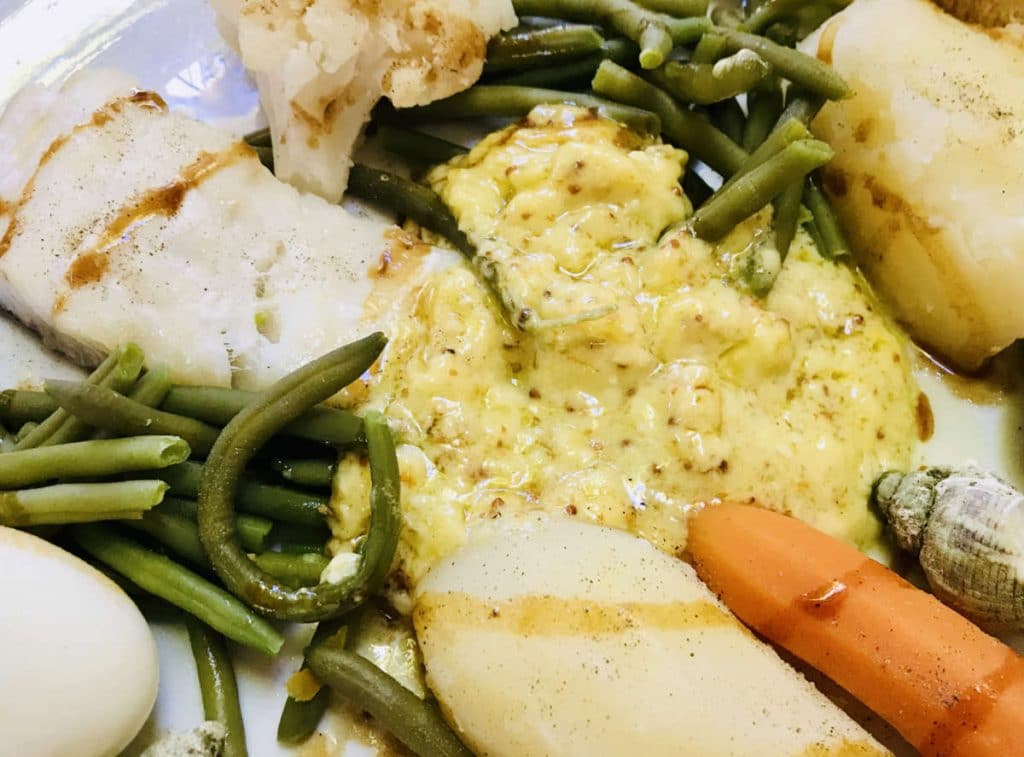
Aioli is a version of mayonnaise, with a lot more garlic in it. The mayonnaise part is made by mixing egg yolks and olive oil till it emulsifies, with it turning into aioli once the garlic is added.
The aioli sauce itself has quite a strong taste (if made correctly), so it is served alongside steamed codfish and fresh vegetables. You can get the aioli recipe here.
20. Croque Monsieur
The Croque Monsieur may be a glorified ham and cheese sandwiches, but it is a French national treasure. Croque translates in English as “to bite”.
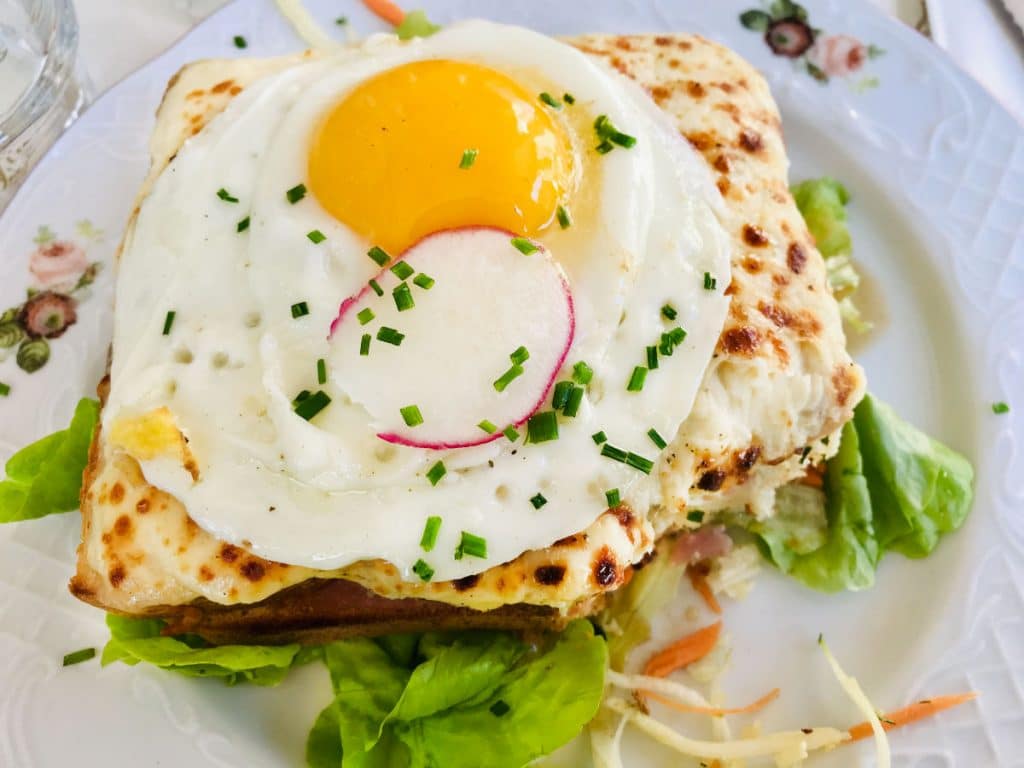
Laden with French butter, cream and cheese, this is the sort of sandwich you must eat as the French do, i.e. with a knife and a fork. You can also try a Croque Madame which has a fried egg on top. You can get the recipe for Croque Monsieur here.
21. Steak Tartare
Tartare is a French culinary term, referring to a number of dishes served raw, rather than cooked. It usually involves raw meat in a steak tartare but you can also see fish chopped or shredded into small pieces.
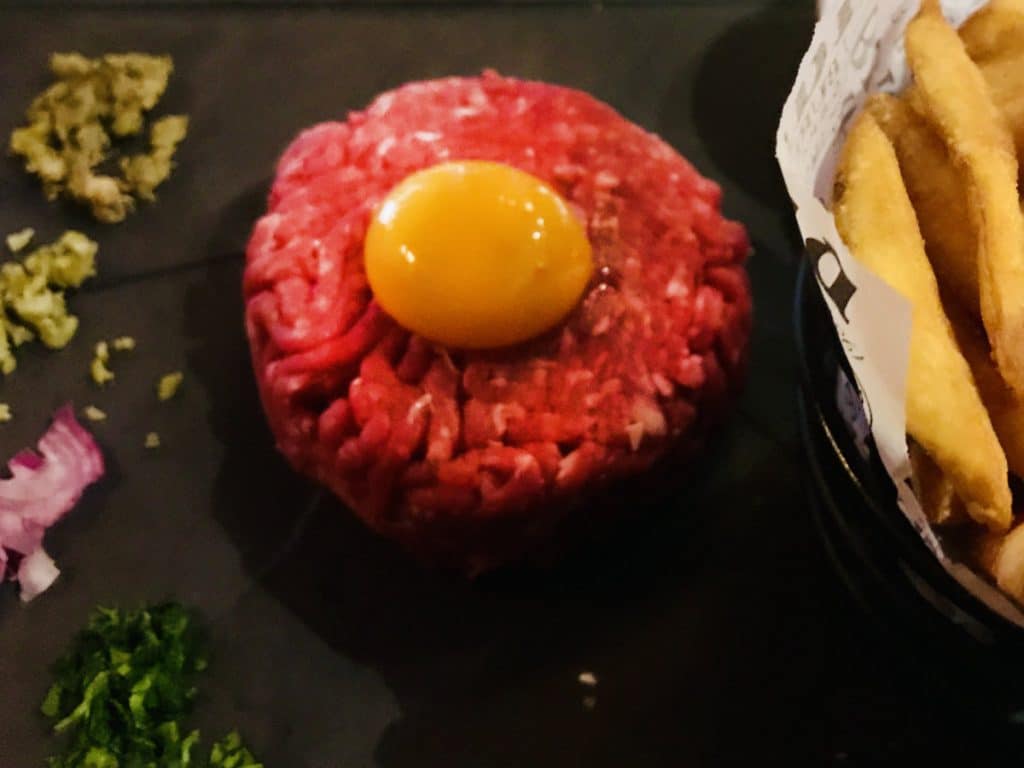
It is usually served with a light salad and fries for a light lunch or dinner. You can find recipes for the steak tartare and salmon tartare here.
22. Ratatouille
Ratatouille is a vegetable stew from Nice, Provence in the South of France. It usually features an assortment of local vegetables, such as eggplant, zucchini, peppers, and tomatoes.
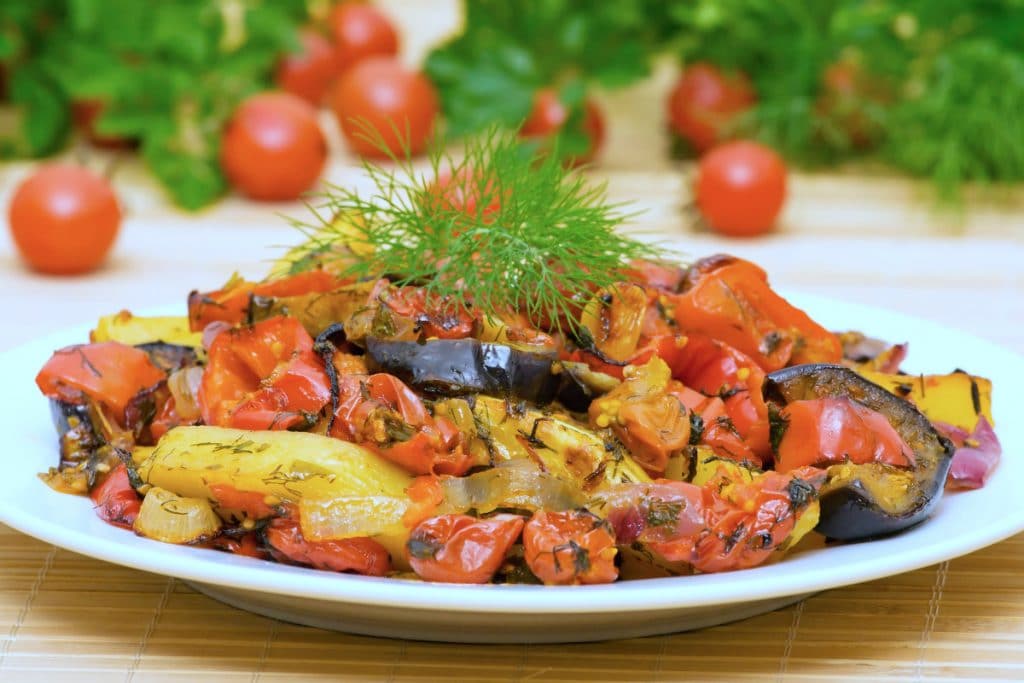
The word “rata” is thought to be army slang for ragoût, meaning “motley stew”. (The current-day version of a ragôut is a similar, but has meat in it.).
You can also try a variation of the ratatouille called the Bohemian Aubergine, which is a touch sweeter and tangier. You can get the recipe for ratatouille here.
23. Bouillabaisse
Bouillabaisse is a traditional stew originating from the port city of Marseille. It was originally a stew made by fishermen, using the bony rockfish from the bottom of their fishing nets, which they were unable to sell to restaurants or fish markets.
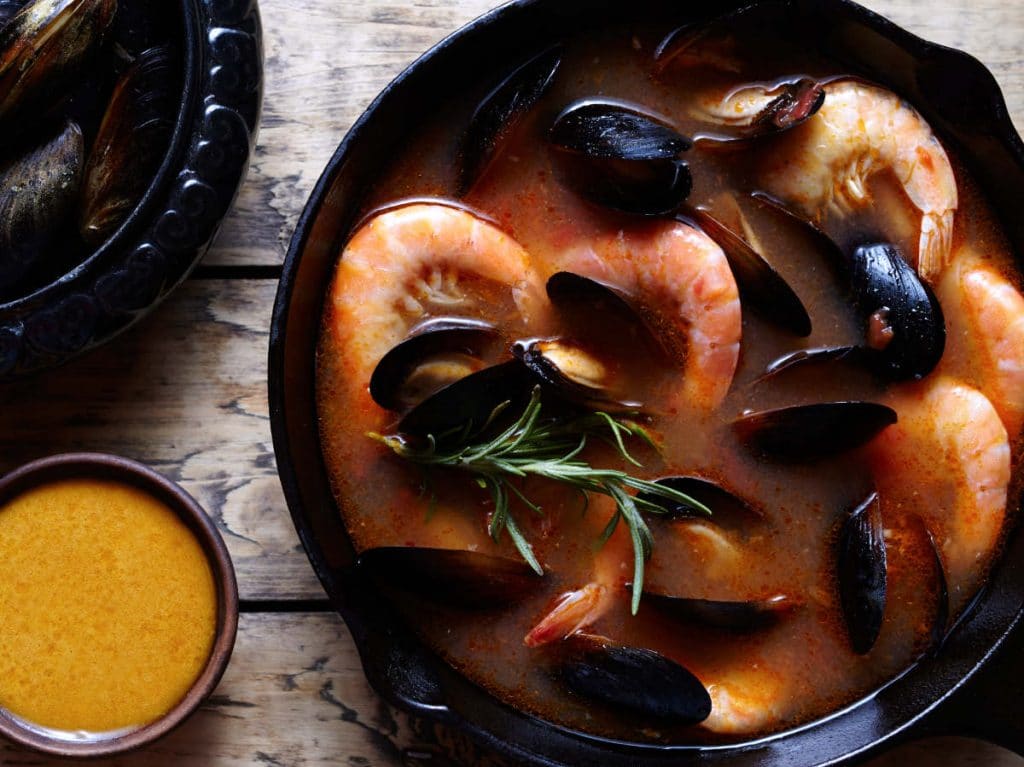
These days this delicate fish stew is considered haute cuisine. It has become so popular that an official “charte de bouillabaisse” was drawn up with an official recipe to avoid cheap pretenders.
Along with the bouillabaisse, a spicy mayonnaise called a rouille is served, made with olive oil, garlic, saffron, and cayenne pepper. You can get an adapted recipe for bouillabaisse here.
24. Coq au Vin
If you don’t eat beef and are looking for an an alternative to the boeuf bourguignon, the classic coq au vin with chicken is everything you can ask for.
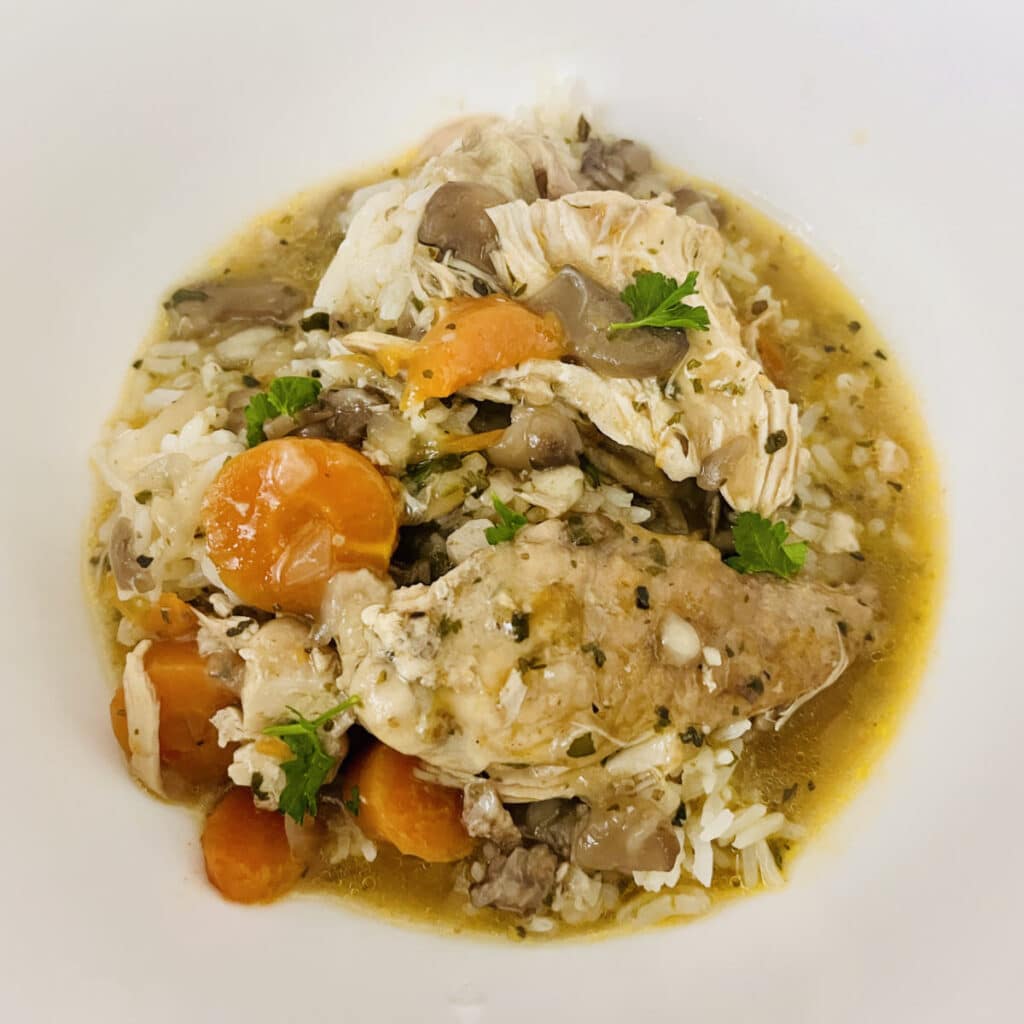
A chicken slow-cooked with vegetables in a stew with wine sauce to tenderize it and bring out the flavors. You can get the recipe for coq au vin here.
25. Blanquette de Veau
All across France, in brasseries up and down the country, you will find the blanquette de veau. It is one of the grand classics of French gastronomy, made with veau, meaning veal.

It is a very simple dish, made with meat, vegetables, and a white sauce. Blanquette comes from the French word blanche meaning “white” and refers to the sauce made from cream and butter, or flour.
These days there are plenty of top chefs putting their own spin on it, including using chicken or pork instead, since veal isn’t the easiest to find. You get find a recipe for creamy chicken blanquette here.
26. Salade Niçoise
The salad niçoise is one of those recipes that even French chefs can’t agree on. Green beans and potatoes? Tuna or anchovies? And mayonnaise!?
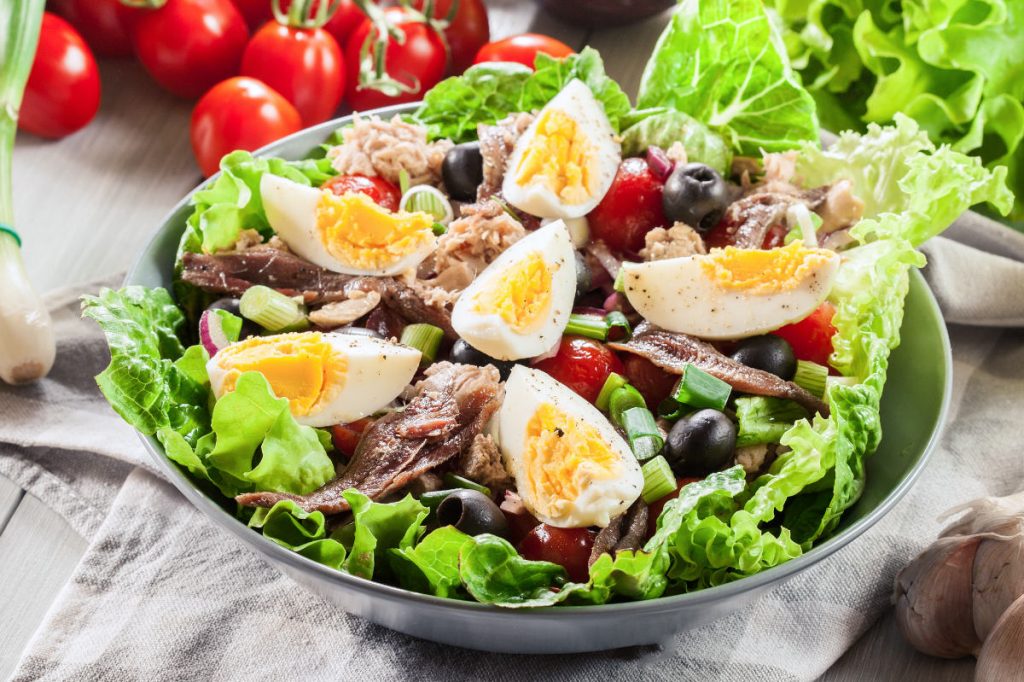
The biggest controversy is over the green beans and potatoes. Several famous French chefs have weighed in on the topic. Former Nice mayor Jacques Médecin proclaimed in his 1970s cookbook: “never, never, I beg you, include boiled potato or any other boiled vegetable in your salad niçoise.”
Get the traditional salad niçoise recipe from Nice and see what the controversy is all about.
27. Chicken Provençale
Chicken Provencal brings together the traditional ingredients from Provence, in the South of France.
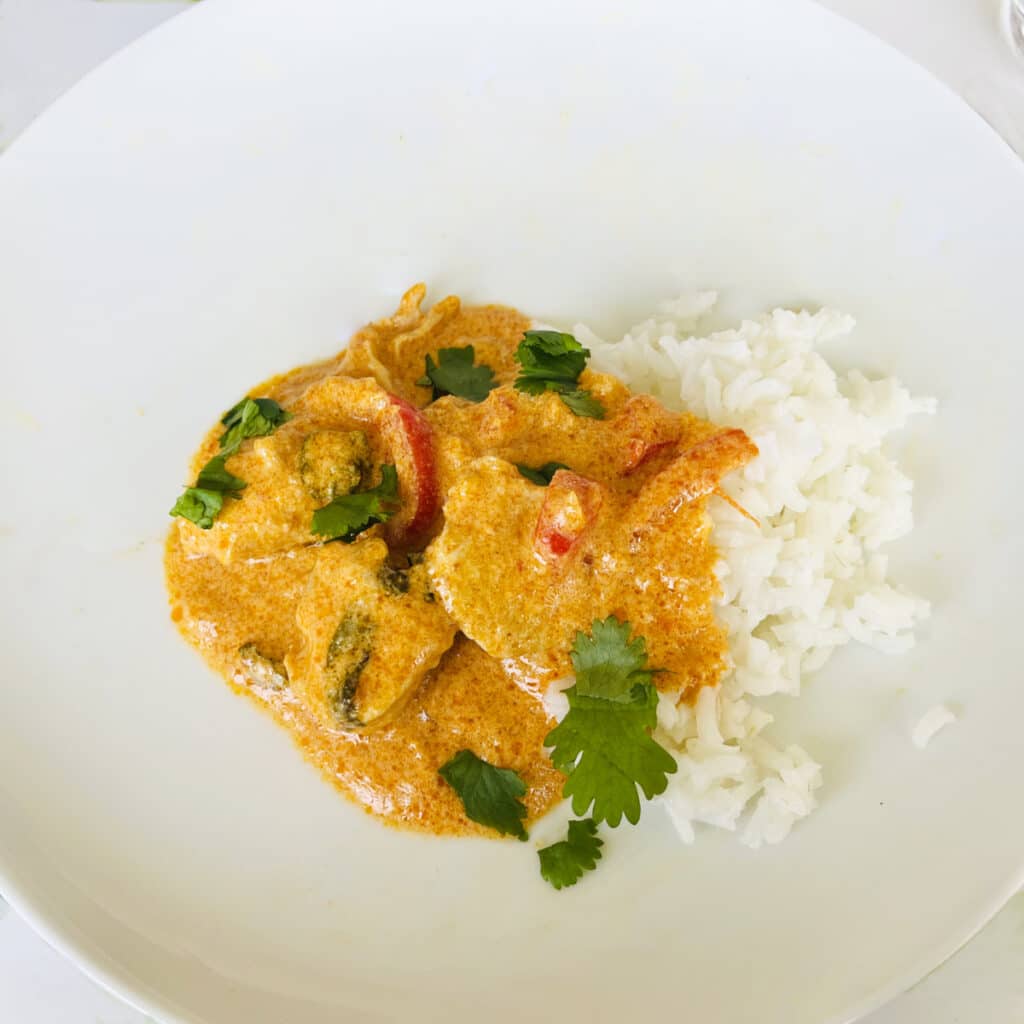
Typically it includes red and green peppers, potatoes, chicken and bacon lardons. Add to that the typical local ingredients of herbs, tomatoes, and olives, this French chicken stew will remind you of summer. You can get the recipe for chicken provençale here.
28. Oysters
Another classic French appetizer is oysters, especially if you are trying to add a touch of je ne sais quoi to your dinner.
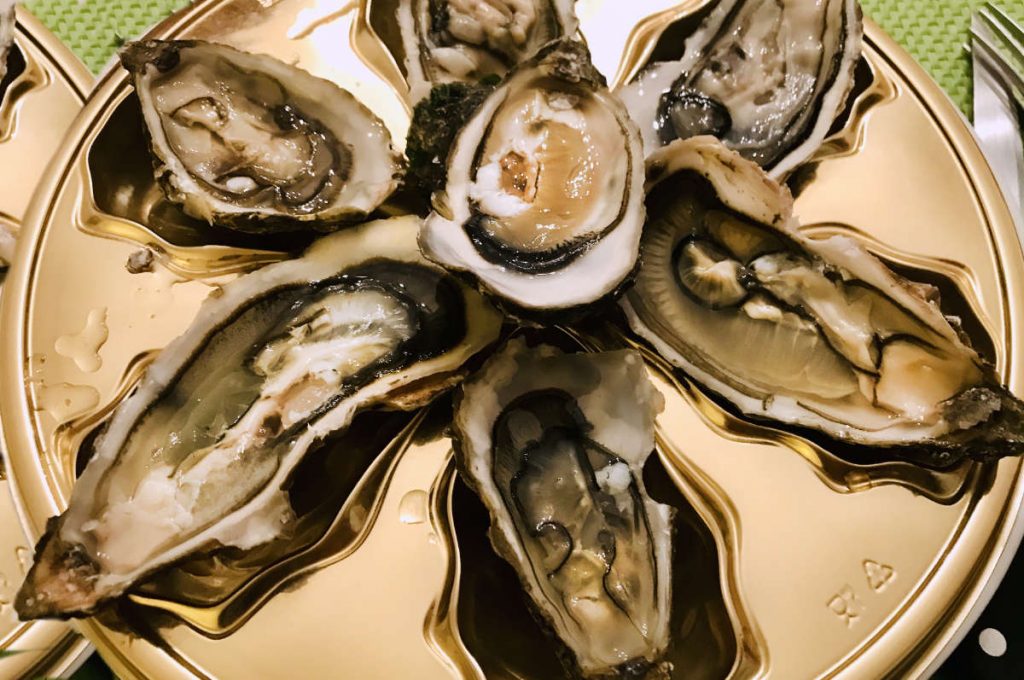
Fresh oysters are not usually cooked in France, but served as is, fresh from the ocean. Fresh oysters are a must-have in France for Christmas and New Year’s eve.
The hardest part about serving oysters is opening the top shell. But once that is done, just squeeze a bit of lemon on them and serve in a tray.
Be sure to dine at a reputable restaurant, as you do not want to risk food poisoning from bad oysters!
29. Charcuterie and cheese platter
You may think you have had a cheese and charcuterie plate at home, but this is one of those dishes that you really need to try in France.
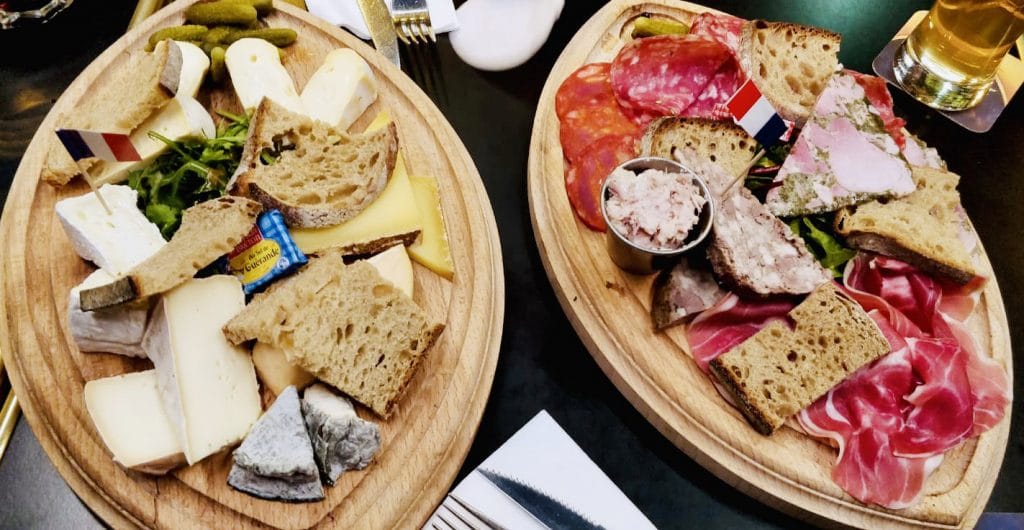
Try a variety of jambon cru, terrines, pâtés, and rillettes paired alongside various French cheeses and wines from all over the country. You can read more about composing a French charcuterie and cheese board here. And don’t forget the crudités!
30. Quenelles
The city of Lyon considers itself to be the gastronomical capital of France. And one of dishes Lyon is famous for is the quenelles.
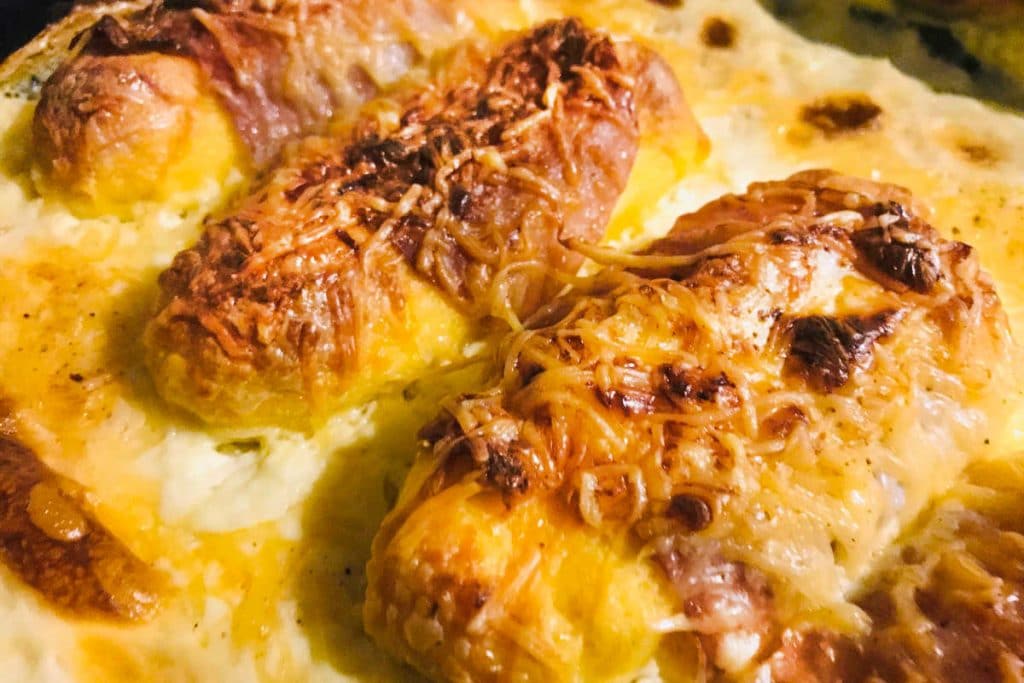
Quenelles are a traditional mixture of dough, cream, egg yolk, and and sometimes pike fish.
After the quenelle is formed in a sausage-shaped pastry, it is cooked in a creamy sauce. It can be served as an appetizer or as a main. You can find the recipe to make quenelles here.
31. Macarons
Macarons might be as ubiquitous in North America today as the cookie is in France, but there’s still something to be said to having one freshly prepared at one of Paris’s finest patisseries.

Try ones at Pierre Hermé or Ladurée, but my favorite is Café Pouchkine near Place de la Madeleine. You can read about more French desserts here.
32. Calissons
The traditional sweet from Aix-en-Provence is not a dessert, but more of a confiserie (candy) made from melon and almond paste and is very sweet.
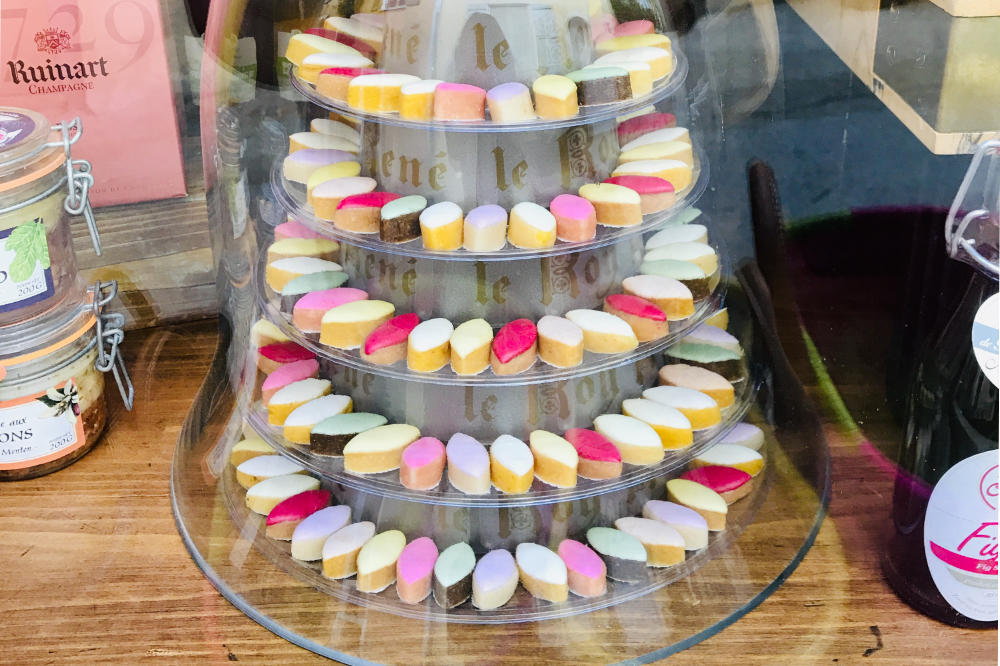
You won’t find it on the menu of a Parisian restaurant, but rather in patisseries in Provence and the south of France. It is traditionally served as one of the 13 desserts of Provence at Christmas.
They are catching on in popularity like the macaron however, so perhaps soon to come to a grocery store near you?
33. Café Gourmand
This is the dessert you pick at a French restaurant if you can’t decide which dessert to get. The café gourmand is a small cup of coffee served with 3 small-size desserts.

You don’t get to pick the dessert, that will be the “surprise du chef” as we say in French, but the choices and varieties of cakes are usually pretty good.
Note: The coffee that you will be served with a café gourmand is, by default, an espresso. For a larger cup of coffee or decaf, you can explore the possibilities of ordering coffee in France here.
34. Meringue
A meringue is a type of dessert or candy made from whipped egg whites and sugar, along with an acidic ingredient such as lemon, vinegar, or cream of tartar.
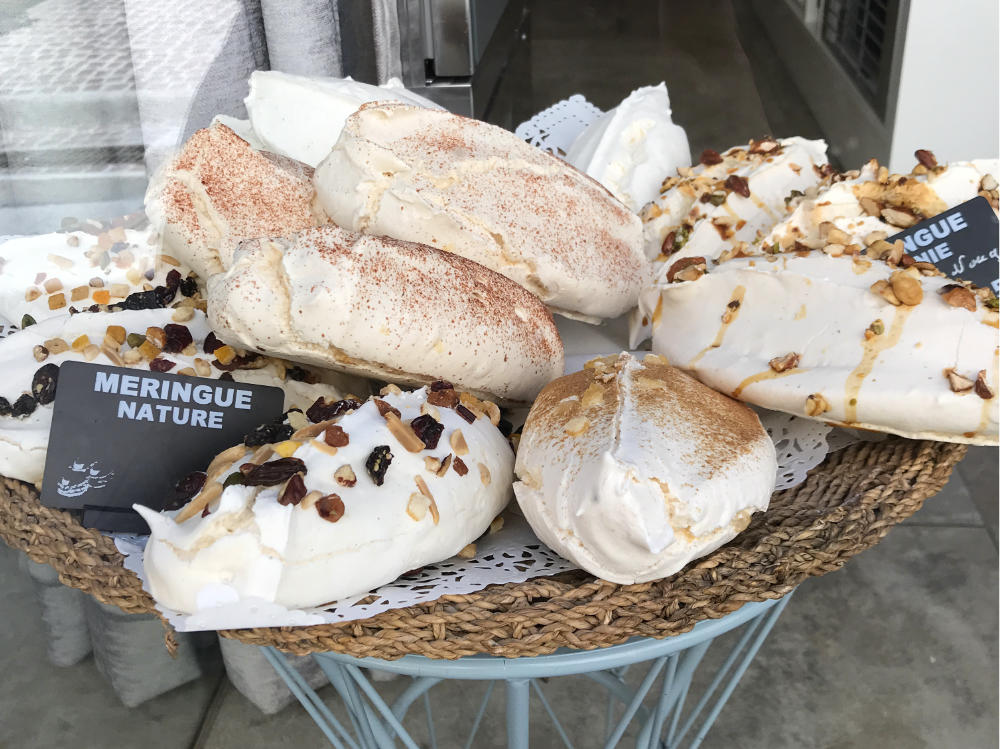
The traditional meringue from Provence is hardish on the outside, and soft and airy on the inside. They come in many flavors such as lemon or lavender, and are often topped with nuts.
35. Religiouse
The name religiouse means “nun”, but there is nothing nun-like about this little puff pastry.

It is made with two choux pastry, one larger than the other and filled with crème. It can also be filled with chocolate or mocha cream. It is then usually covered on top with chocolate icing.
Unless you are invited to a traditional French wedding where you can taste the somewhat similar piece montée, you will have to settle for getting a religiouse at a local patisserie (French bakery shop).
36. Vin Chaud
Whether it is called Vin Chaud, Glühwein, or Glögg, or whatever it is called, this classic mulled wine recipe is a perfect treat for at Christmas and those cold winter winter holidays.
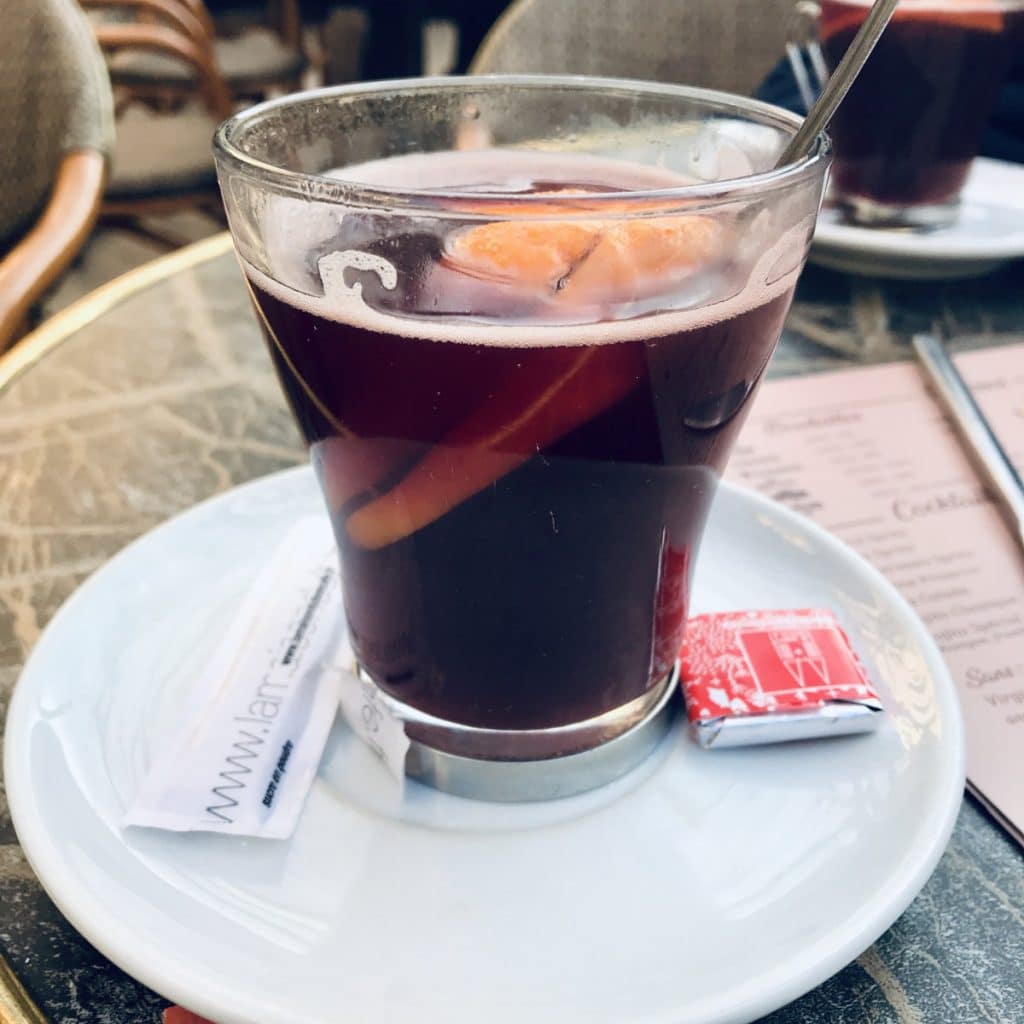
On those freezing cold winter nights, there is nothing like having a warm cup of vin chaud in your hands. The wine is heated and then spices like cinnamon, ginger, cloves, nutmeg, cardamom, and sugar were added.
You can get the recipe for vin chaud here, as well as a non-alcoholic version of this mulled wine.
37. Pastis
Traditionally from Provence, Pastis de Marseille is the apéritif that has become a favorite all over France. However, with an alcohol content of 45% and sharp licorice flavor, pastis is a liquor that most foreigners find is an acquired taste.
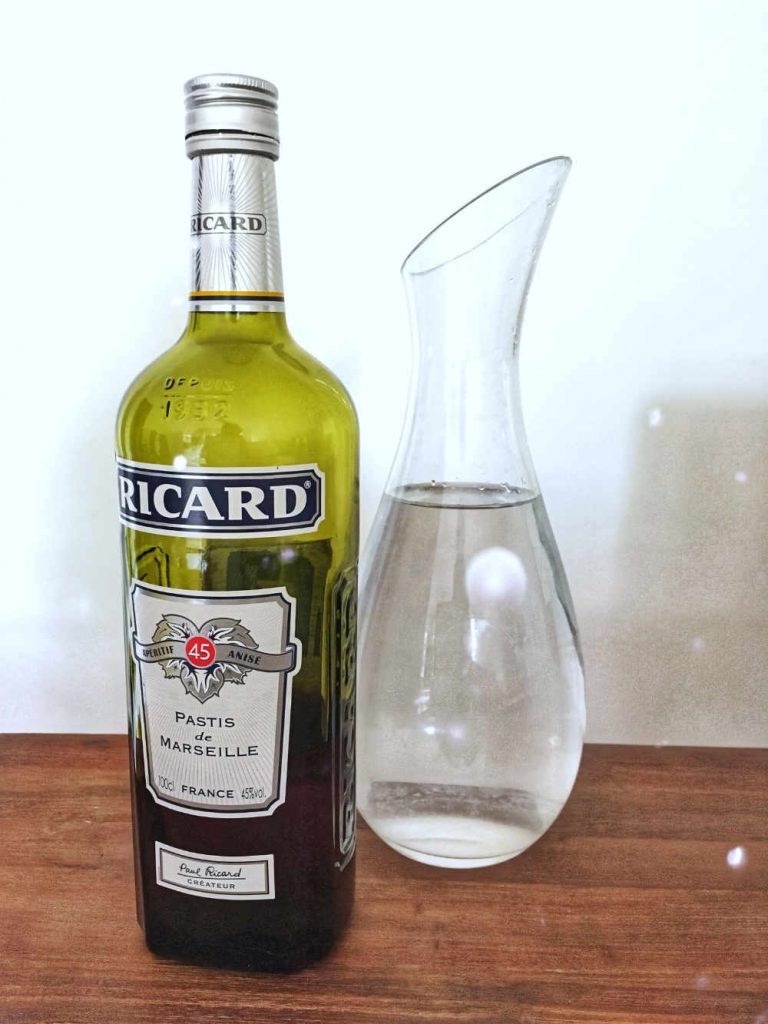
It tastes a bit like the greek ouzo, however it is so strong, it must be watered down when served.
You will easily find it on the menu of every French bar, brasserie, and café (and if you don’t you should question their French credentials!). You can read more about the French love of pastis here.
38. Kir
Along with Pastis, Kir is also an apéritif that you will find on every menu around France.

There are a few variations of kir depending on the region:
| Type | Recipe |
|---|---|
| Kir | White wine mixed with Crème de Cassis |
| Kir Royale | Champagne or any type of sparkling white wine, mixed with Crème de Cassis |
| Kir Breton ou Normand | Cider mixed with Crème de Cassis |
Normally a white wine like aligoté from Burgundy, or a crémant from Loire is used as the base for kir. (A crémant is a type of sparkling wine.)
Crème de Cassis is a sweet liquor that is made with blackcurrant. You can also use other crème liquors like Crème de Chambord (raspberry) or Crème de Pêche (peach), if you prefer. You can read more about Kir and Kir Royale Chambord here.
39. Chocolat chaud
You simply cannot come to Paris and not try the chocolat chaud. Hot chocolate, but not the industrial powdery stuff that you get at a grocery store.
The real chocolat chaud at a chocolaterie like Angelina or Ladurée, will be made from the finest chocolate melted in a pot, with sugar, vanilla, cinnamon and just a hint of milk. Each chocolatier will have his own recipe, so don’t hesitate to try a few different types to find your favorite 😉
40. Dijon Mustard
Now, if you are visiting city of Dijon, you have to try (and take home) a bottle of the classic Dijon mustard. There are several flavors of dijon, with everything from honey mustard to a spicy variety that will pique your interest.
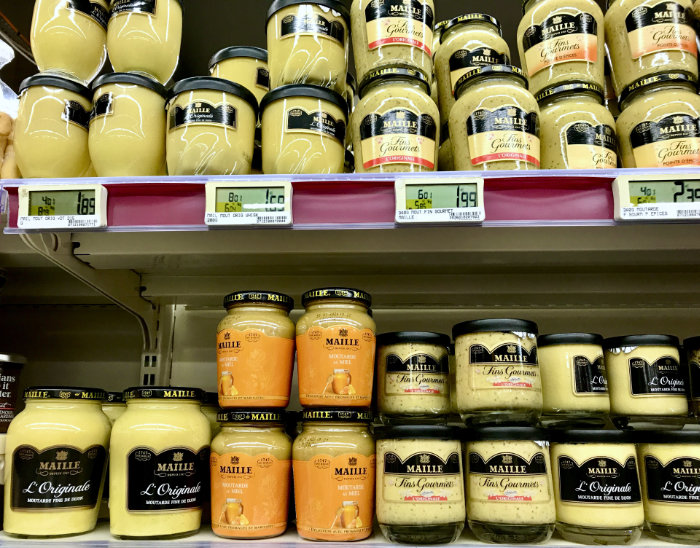
This traditional mustard is regularly used in recipes, so the locals usually keep a bottle handy in that quintessential French pantry.
41. Cognac and Armagnac
Cognac is a type of brandy that comes from the French town of Cognac in Nouvelle Aquitaine (similar to Champagne which can only come from the Champagne region of France).
After the grapes are pressed, the juice fermented for a couple of weeks with wild yeast from Cognac converting the sugar into alcohol. It is then distilled and aged in oak casks for at least two years, giving it an alcohol content of around 40%.
The cognac is blended with different cognacs from different years by a master blender (maître de chai) to come up with the perfect taste.
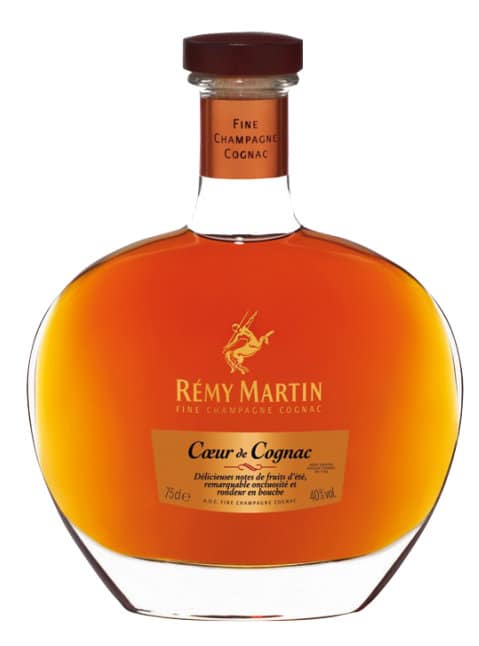
Similar to Cognac, Armagnac is an aged brandy from the region of Armagnac, near the foothills of the Pyrénees mountains (near Spain). The area it is produced in is much smaller, however, which is why it is not usually exported outside of France, and thus not as well known.
For French people though, it is Armagnac that is more popular, being the oldest French brandy, which used to be consumed reputedly for “therapeutic benefits”. In addition, there is Pineau de Charentes which is a fortified wine made from unfermented grape juice and cognac.
42. Boudin Blanc
Known as the “white sausage”, boudin blanc is a mix of cream, breadcrumbs, fat, starch, and boiled pork or chicken, all stuffed into a sausage casing.
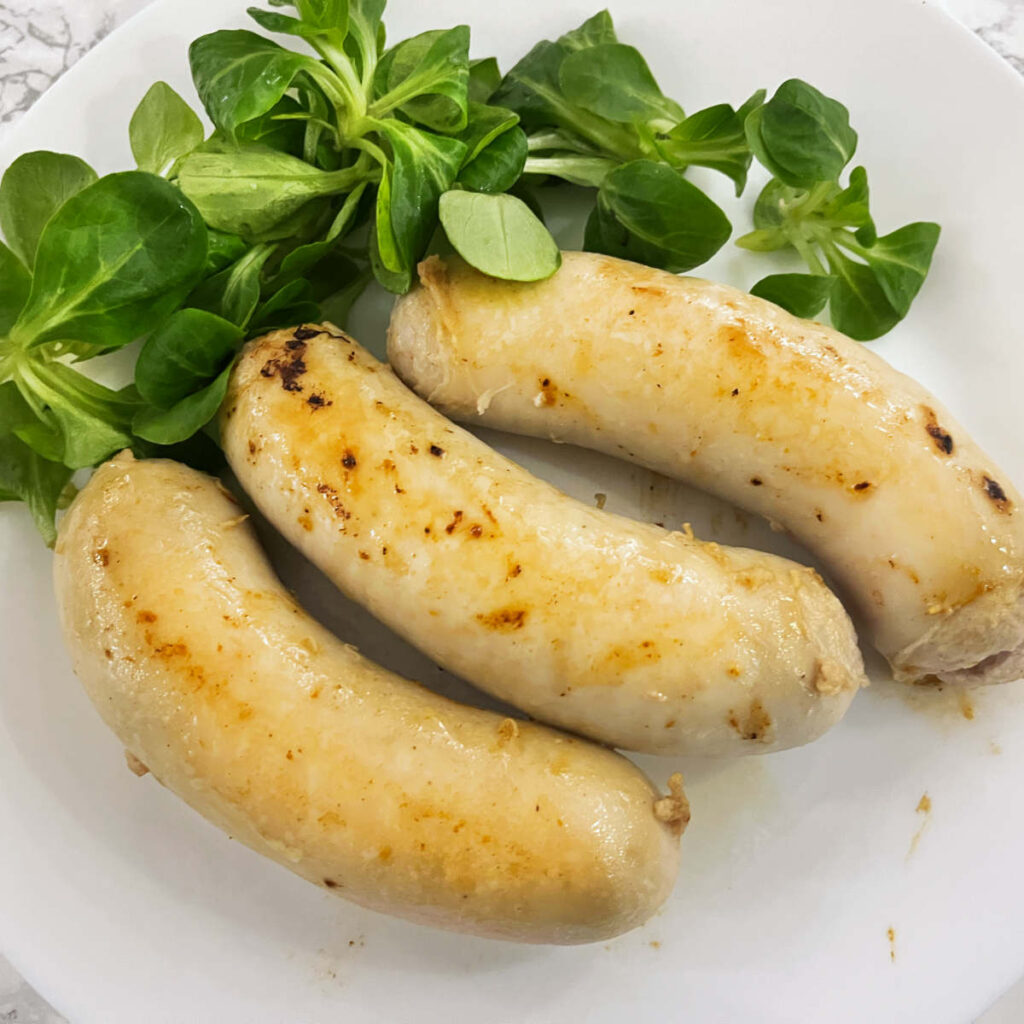
It is a dish that dates back to the Middle ages, when it became particularly popular in Lyon. (Its cousin, the Boudin noir, includes dried pork blood.)
It became a staple across France during tough times like war and famines, when meat was at a shortage and people had to make do. It also became a Christmas tradition, eaten before the large dinner.
Today, it is a much loved delicacy all across Europe and parts of North America, available at local butchers and in gourmet food stores. You can read more about cooking boudin blanc here.

If you enjoyed that article, you may like to read more food facts about France as well as about French dining etiquette. A bientôt!
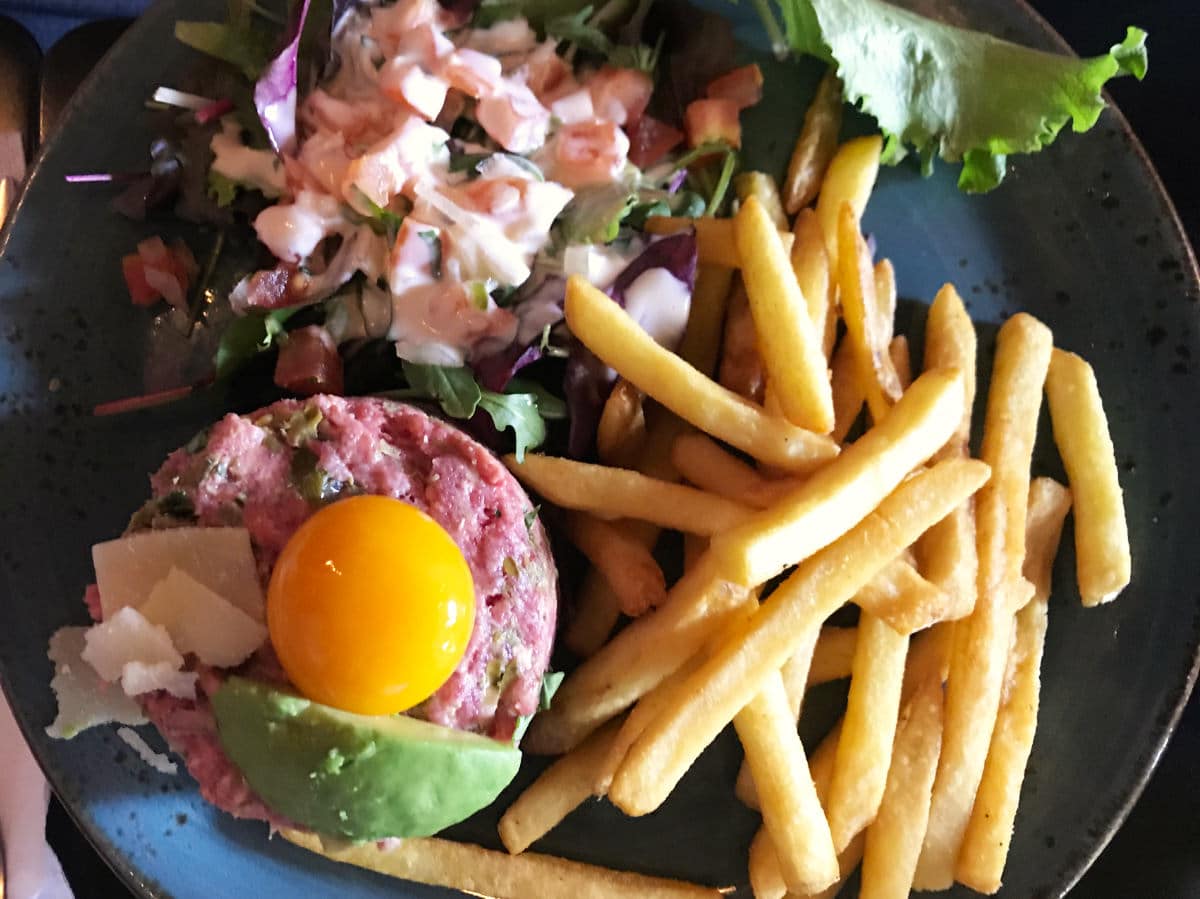




I love French food! can’t wait to try some of these on my next trip over the pond.